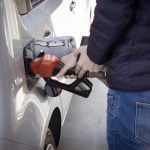Worried about what regular gasoline is doing to your car and the environment? Alternative fuels like E85 are a quick and effective solution. So, what is E85 gas? Find out whether your car can run efficiently on this flex fuel.
What is E85 Gas?
E85 is a Flex Fuel, a high-level blend of ethanol and gasoline. The ethanol content in Flex Fuels ranges from 51% to 83%, depending on the season and geography. E85 contains 85% ethanol and can be used for FFV (Flexible Fuel Vehicles). The ethanol content in the fuel significantly reduces emissions and can save money in the longer run.

Before we dive head first into the pros and cons of E85, it’s essential to understand the basics of ethanol fuel.
Is There Ethanol in Your Fuel?
Over 98% of gasoline sold in the USA contains some ethanol. E10 is the most common variant – it contains 10% ethanol and 90% gasoline. The ethanol in Flex Fuels helps reduce air pollution by oxygenating the fuel.
How is Ethanol Made?
Ethanol (ethyl alcohol or EtOH) is a colorless liquid made from “biomass,” containing various plant materials like corn grain. It is renewable and domestically produced for transportation fuel. 94% of the ethanol produced in the US is derived from corn grain starch.
Ethanol production facilities in the country collect biomass feedstock, convert it into fuel, and distribute it via fuel terminals. While E10 is commonly available at fuel terminals, E85 can be sourced directly from the production facility too.
Difference Between E85 and Regular Gas
Gas stations in the US sell three common types of fuel – Regular Gasoline, Midgrade Gasoline, and Premium Gasoline. Regular gas is the lowest octane fuel, which implies it is the least stable.
E85 gas has higher octane than regular ones meaning it is a lot better for the engine and it is way cleaner than regular petrol.
On the downside, E85 burns quickly and creates less energy than normal gas. Because denatured ethanol has around 30% lower energy/gallon than normal gasoline.
Reportedly, Indy 500 racers usually use E85 fuel for their race cars because of its high octane. Though ethanol burns much faster than gasoline, its higher-octane rating helps prevent engine knocking and improve drivability.
Can You Use E85 Gas in Any Car?
E85 can be used for Flexible Fuel Vehicles (FFV) only. FFVs are built to run on both gasoline and flex fuels containing up to 85% ethanol. Except for a few modifications in the fuel system and engine, these cars are similar to gasoline-only models. And they are more common than you think. You might own an FFV and not know it!
What are FFVs?
Flexible Fuel Vehicles have been around since the 1900s! There are more than 21 million FFVs in the US, and 100+ models are available in the market.
Flex Fuel cars don’t look any different than gasoline models. But they can run on both gasoline and Flex Fuels like E85 gas. FFVs have an internal combustion engine, and some models are said to produce more torque and horsepower with flex fuels than regular cars.
How to Identify an FFV
The easiest way to identify an FFV is to check the car’s gas cap. FFVs have a yellow fuel filler ring or gas cap. Some E85 flex-fuel vehicles also have labels indicating the fuel type; they are usually found next to the fuel door. Look for badges like “E85,” “Flex-Fuel,” or “FFV,” too.
You can check the owner’s manual to determine which fuels can be used in your car. Car Manufacturers’ websites also have this information.

What is the E85 Gas Price?
Gasoline prices are dependent on the gas station’s location, the political climate in the country, time of year, and several other factors. Alternate fuels like E85 also have price fluctuations due to these factors. However, generally, E85 is much cheaper than regular gasoline and E10. You can check the current E85 gas rates in the country on the E85prices.com.
Where Can I Find E85 Gas near Me?
The US tops the world in fuel ethanol consumption with 949.23 thousand barrels per day. There are over 39K E85 gas stations across the country, covering 42 states. You can locate Flex Fuel gas stations online.
Important: Ethanol is poisonous and flammable; it is not to be confused with beverage alcohol. All safety measures applicable to gasoline must be taken around E85 and other Flex Fuels.

What Are the Pros and Cons of E85 Gas?
70% of petroleum consumption and 30% of the country’s total energy needs come from the transportation sector. As E85 is cheaper than regular gas, it helps reduce transportation energy costs.
A notable advantage of using E85 gas is that it helps reduce emissions. The carbon dioxide emitted by vehicles using Flex Fuels is offset by the feedstock crops grown to produce ethanol. Using petroleum products like regular gas does not offset any carbon dioxide produced by vehicles.
As ethanol produces less energy per gallon than gasoline, the main concern about E85 is decreased fuel economy. In comparison to regular gas, you’ll get lower MPG with E85. But you can also look at it this way:
Ethanol doesn’t leave any burning deposits, as it is an excellent solvent. So, E85 effectively cleans the engine, fuel injectors, valves, and exhaust system. E85 is better for your vehicle’s health and lowers maintenance costs in the long run.
As for the lower MPG, consider that E85 costs much less than regular gas. So, even when mileage reduces, you could be saving money on fuel costs. Besides, if your vehicle’s engine is optimized for high-level blends like E85, the fuel economy can improve.
Renée Martin is a travel and car expert who focuses on road and air travel in the U.S. For the past 6 years, she’s been helping make driving and trip planning easier and budget-friendly for everyday travelers.














